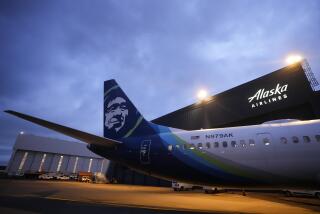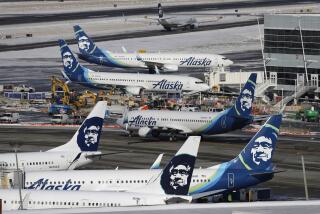Medical Records of Controller in Fatal LAX Crash Withheld : Air safety: The FAA refuses to turn over documents to investigators, citing concerns about privacy.
- Share via
The Federal Aviation Administration has refused to turn over to investigators the medical records of an air traffic controller who directed two airliners onto the same runway at Los Angeles International Airport moments before one struck the other in a fiery crash.
The National Transportation Safety Board had requested the records pertaining to Robin Lee Wascher and other controllers as part of its investigation to determine the cause of the Feb. 1 collision between a USAir Boeing 737 and a SkyWest commuter plane that killed 34.
However, on Feb. 22, James B. Busey, administrator of the FAA, which employs controllers at civilian facilities throughout the United States, departed from customary policy and declined to release the records.
In his letter to James Kolstad, NTSB chairman, Busey said that while he generally agreed with the policy of sharing such information with the board, he wanted “to ensure that such records are appropriately interpreted and accorded the utmost possible protection in the interest of personal privacy.”
“I do not intend to make records available to the board without assurances that they will be reviewed only by qualified medical personnel and that they will not be made part of the board’s private docket,” Busey wrote. “At present, I understand that the board has neither qualified medical personnel on staff to review such records nor a procedure to ensure confidential treatment.”
Neither Wascher nor Kolstad could be reached for comment.
During several recent NTSB investigations, some supposedly confidential information compiled as part of the probe has been leaked to the news media.
Just a day after the runway collision in Detroit last Dec. 3 that killed eight, the National Air Traffic Controllers Assn. talked to reporters about confidential tape recordings of conversations between cockpit crews and air traffic controllers in the moments before that accident.
Because of the leak, NTSB board member Jim Burnett said he decided to exclude the controllers’ organization from further participation in the Detroit investigation.
Busey noted in his letter to Kolstad that in August, 1988, the FAA had amended earlier policy to provide for the release of controllers’ medical records to the board “as a routine use.”
He said the earlier policy was amended “in recognition of the board’s interest in determining whether air traffic controllers whose conduct may have been a factor in an accident had the physical and psychological capacity to perform their assigned functions.”
Wascher, who was placed on leave from her duties at the Los Angeles control tower immediately after the accident here, has since returned to work. Instead of directing traffic at the airport, FAA officials said, she is performing administrative duties at the FAA’s regional headquarters in Hawthorne.
With NTSB concurrence, the FAA on Monday released recordings of radio conversations between controllers and cockpit crews from about 10 minutes before the crash until about five minutes afterward.
The tapes showed--as Burnett had told reporters shortly after the accident--that Wascher directed SkyWest Flight 569 to taxi onto the midpoint of Runway 24 Left, prior to takeoff. One minute and 9 seconds later, she gave USAir Flight 1493 permission to land on the same runway.
Just over a minute later, an as-yet-unidentified male voice is heard to say, “What the hell?” It was about then, investigators said, that the Boeing 737 slammed into the commuter plane.
Wascher sounded poised throughout the entire 15-minute recording. Even after the accident, her voice remained calm as she directed other aircraft away from the accident site.
Sources close to the investigation say she apparently was initially unaware that two planes had collided, believing instead that the landing aircraft had exploded on its own.
According to Burnett, Wascher later told investigators that she had confused the SkyWest plane with another aircraft on a nearby runway.
More to Read
Inside the business of entertainment
The Wide Shot brings you news, analysis and insights on everything from streaming wars to production — and what it all means for the future.
You may occasionally receive promotional content from the Los Angeles Times.










